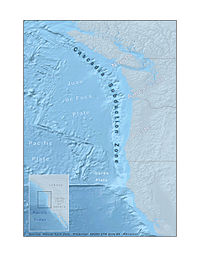45°N 124°W / 45°N 124°W The Cascadia subduction zone is a 960 km (600 mi) fault at a convergent plate boundary, about 100–200 km (70–100 mi) off the Pacific coast, that stretches from northern Vancouver Island in Canada to Northern California in the United States. It is capable of producing 9.0+ magnitude earthquakes and tsunamis that could reach 30 m (98 ft). The Oregon Department of Emergency Management estimates shaking would last 5–7 minutes along the coast, with strength and intensity decreasing further from the epicenter.[1] It is a very long, sloping subduction zone where the Explorer, Juan de Fuca, and Gorda plates move to the east and slide below the much larger mostly continental North American plate. The zone varies in width and lies offshore beginning near Cape Mendocino, Northern California, passing through Oregon and Washington, and terminating at about Vancouver Island in British Columbia.[2]
The Explorer, Juan de Fuca, and Gorda plates are some of the remnants of the vast ancient Farallon plate which is now mostly subducted under the North American plate. The North American plate itself is moving slowly in a generally southwest direction, sliding over the smaller plates as well as the huge oceanic Pacific plate (which is moving in a northwest direction) in other locations such as the San Andreas Fault in central and southern California.
Tectonic processes active in the Cascadia subduction zone region include accretion, subduction, deep earthquakes, and active volcanism of the Cascades. This volcanism has included such notable eruptions as Mount Mazama (Crater Lake) about 7,500 years ago, the Mount Meager massif (Bridge River Vent) about 2,350 years ago, and Mount St. Helens in 1980.[3] Major cities affected by a disturbance in this subduction zone include Vancouver and Victoria, British Columbia; Seattle, Washington; and Portland, Oregon.
- ^ "Oregon Department of Emergency Management : Cascadia Subduction Zone : Hazards and Preparedness : State of Oregon".
- ^ Cite error: The named reference
Schulz2015was invoked but never defined (see the help page). - ^ "Cascadia Subduction Zone Volcanism in British Columbia". Archived from the original on 2010-06-02. Retrieved 2008-12-18. USGS

